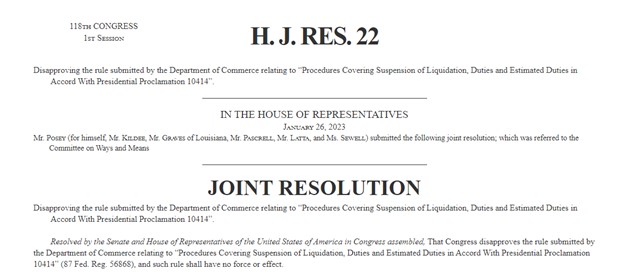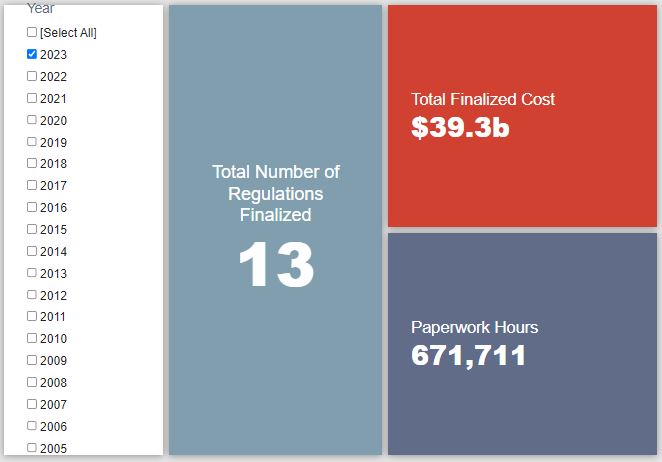Week in Regulation
January 30, 2023
Heavy-duty Vehicle Emissions Rule Provides Biggest Splash of 2023 Thus Far
With merely eight rulemakings containing some measurable economic impact, it was a relatively brisk week in the pages of the Federal Register. Among those rules, however, was the most significant one so far in the new year. The Environmental Protection Agency’s (EPA) latest round of emissions standards for heavy-duty vehicles finally made its way down the administrative highway and delivered its regulatory cargo. Across all rulemakings, agencies published $40 billion in total costs and added 213,857 annual paperwork burden hours.
REGULATORY TOPLINES
- Proposed Rules: 38
- Final Rules: 46
- 2023 Total Pages: 5,710
- 2023 Final Rule Costs: $39.3 billion
- 2023 Proposed Rule Costs: $15.7 billion
NOTABLE REGULATORY ACTIONS
The most consequential rulemaking of the week – and again, of the year to-date – was the EPA rule on “Control of Air Pollution From New Motor Vehicles: Heavy-Duty [HD] Engine and Vehicle Standards.” As with most vehicular emissions rules in recent years, the economic impacts reach well into the billions of dollars. For this rule, EPA estimates present value costs over nearly 20 years of $39 billion, or $3.8 billion on an annualized basis. It is important to note, however, that this rule only focuses on “criteria pollutants” such as ozone and particulate matter rather than greenhouse gas (GHG) emissions that have been central to many similar rules of late. EPA expects “to consider potential changes to certain HD GHG Phase 2 standards as part of a subsequent rulemaking.”
TRACKING THE ADMINISTRATIONS
As we have already seen from executive orders and memos, the Biden Administration will surely provide plenty of contrasts with the Trump Administration on the regulatory front. And while there is a general expectation that the current administration will seek to broadly restore Obama-esque regulatory actions, there will also be areas where it charts its own course. Since the AAF RegRodeo data extend back to 2005, it is possible to provide weekly updates on how the top-level trends of President Biden’s regulatory record track with those of his two most recent predecessors. The following table provides the cumulative totals of final rules containing some quantified economic impact from each administration through this point in their respective terms.
![]()
The heavy-duty vehicle emissions rule discussed above provided the bulk of the surge in Biden-era final rule costs. With that rule in place, the Biden Administration outpaces the Obama Administration in total costs by nearly $150 billion to this point in their respective terms. In terms of developments across the Trump and Obama Administrations, familiar trends continued for each – albeit on a more limited scale than the shift in the Biden total. For Trump, a deregulatory measure from the Department of Labor provided modest cost and paperwork savings. Meanwhile under Obama, a pair of rules regarding financial services issues drove some upward movement in that administration’s cost and paperwork totals.
THIS WEEK’S REGULATORY PICTURE
This week, the 118th Congress sees its first “resolution of disapproval” under the Congressional Review Act (CRA).

The AAF CRA Tracker page finally gets its first update under the new Congress. For those somehow unfamiliar with the CRA at this point, it is a provision that allows Congress to invalidate a regulation put forward by the executive branch. While there are various moving parts to the CRA, two of its most important provisions allow Congress to: 1) sidestep a potential filibuster in the Senate, thus allowing a simple majority vote, for a limited period; and 2) take up consideration of rules published in the waning months of the previous Congress and/or administration. This latest example uses the latter provision to target a September 2022 rule from the Department of Commerce regarding “Procedures Covering Suspension of Liquidation, Duties and Estimated Duties in Accord With Presidential Proclamation 10414.”
What is Proclamation 10414? The proclamation’s title gives a good idea of what it involves: “Declaration of Emergency and Authorization for Temporary Extensions of Time and Duty-Free Importation of Solar Cells and Modules from Southeast Asia.” Essentially it is the Biden Administration giving limited relief on the tariff front to certain imported solar panel components. The administration’s justification for this action is that “immediate action is needed to ensure access to a sufficient supply of solar modules to assist in meeting the United States’ electricity generation needs.”
Typically, successful CRA resolutions have been highly partisan exercises that involved the unique alignment of a fully unified Congress and administration following an administration of the other party. This is primarily due to the inherent dynamic that any component – be it either chamber of Congress or the incumbent administration – represents a potential veto point if it prefers the underlying policy of the rulemaking under fire.
The CRA resolution at hand, however, provides a somewhat uncommon case study in the canon of such actions. The rule it seeks to invalidate involves cross-cutting trade and climate policy issues. Further complicating matters, there has been noticeable political realignment on trade policy priorities and values across both parties in recent years. As such, this CRA resolution enters the fray with a bipartisan set of cosponsors already attached to it. Granted, one still expects President Biden to veto legislation that would deny implementation of his own Proclamation, but the unique political mélange involved merits some attention going forward.
TOTAL BURDENS
Since January 1, the federal government has published $55 billion in total net costs (with $39.3 billion in new costs from finalized rules) and 5 million hours of net annual paperwork burden increases (with 671,711 hours in increases from final rules).











